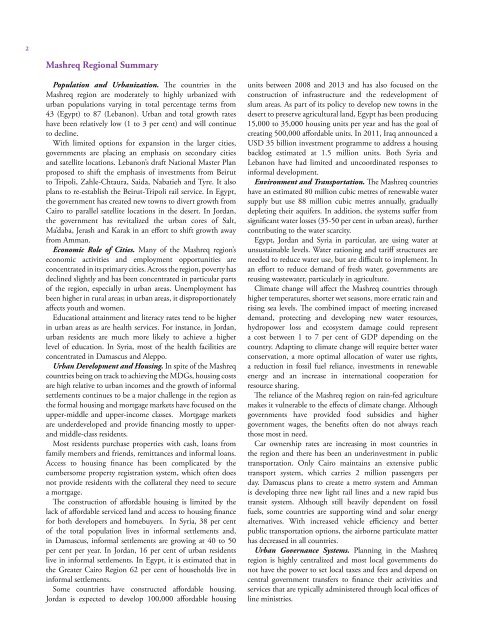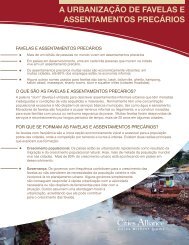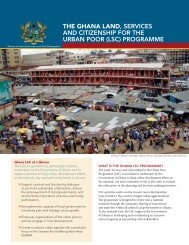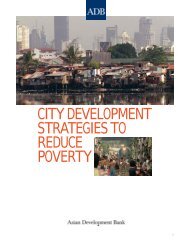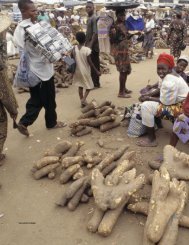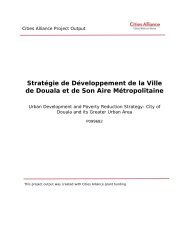Arab Cities2012 - Cities Alliance
Arab Cities2012 - Cities Alliance
Arab Cities2012 - Cities Alliance
You also want an ePaper? Increase the reach of your titles
YUMPU automatically turns print PDFs into web optimized ePapers that Google loves.
2<br />
Mashreq Regional Summary<br />
Population and Urbanization. The countries in the<br />
Mashreq region are moderately to highly urbanized with<br />
urban populations varying in total percentage terms from<br />
43 (Egypt) to 87 (Lebanon). Urban and total growth rates<br />
have been relatively low (1 to 3 per cent) and will continue<br />
to decline.<br />
With limited options for expansion in the larger cities,<br />
governments are placing an emphasis on secondary cities<br />
and satellite locations. Lebanon’s draft National Master Plan<br />
proposed to shift the emphasis of investments from Beirut<br />
to Tripoli, Zahle-Chtaura, Saida, Nabatieh and Tyre. It also<br />
plans to re-establish the Beirut-Tripoli rail service. In Egypt,<br />
the government has created new towns to divert growth from<br />
Cairo to parallel satellite locations in the desert. In Jordan,<br />
the government has revitalized the urban cores of Salt,<br />
Ma’daba, Jerash and Karak in an effort to shift growth away<br />
from Amman.<br />
Economic Role of <strong>Cities</strong>. Many of the Mashreq region’s<br />
economic activities and employment opportunities are<br />
concentrated in its primary cities. Across the region, poverty has<br />
declined slightly and has been concentrated in particular parts<br />
of the region, especially in urban areas. Unemployment has<br />
been higher in rural areas; in urban areas, it disproportionately<br />
affects youth and women.<br />
Educational attainment and literacy rates tend to be higher<br />
in urban areas as are health services. For instance, in Jordan,<br />
urban residents are much more likely to achieve a higher<br />
level of education. In Syria, most of the health facilities are<br />
concentrated in Damascus and Aleppo.<br />
Urban Development and Housing. In spite of the Mashreq<br />
countries being on track to achieving the MDGs, housing costs<br />
are high relative to urban incomes and the growth of informal<br />
settlements continues to be a major challenge in the region as<br />
the formal housing and mortgage markets have focused on the<br />
upper-middle and upper-income classes. Mortgage markets<br />
are underdeveloped and provide financing mostly to upper-<br />
and middle-class residents.<br />
Most residents purchase properties with cash, loans from<br />
family members and friends, remittances and informal loans.<br />
Access to housing finance has been complicated by the<br />
cumbersome property registration system, which often does<br />
not provide residents with the collateral they need to secure<br />
a mortgage.<br />
The construction of affordable housing is limited by the<br />
lack of affordable serviced land and access to housing finance<br />
for both developers and homebuyers. In Syria, 38 per cent<br />
of the total population lives in informal settlements and,<br />
in Damascus, informal settlements are growing at 40 to 50<br />
per cent per year. In Jordan, 16 per cent of urban residents<br />
live in informal settlements. In Egypt, it is estimated that in<br />
the Greater Cairo Region 62 per cent of households live in<br />
informal settlements.<br />
Some countries have constructed affordable housing.<br />
Jordan is expected to develop 100,000 affordable housing<br />
units between 2008 and 2013 and has also focused on the<br />
construction of infrastructure and the redevelopment of<br />
slum areas. As part of its policy to develop new towns in the<br />
desert to preserve agricultural land, Egypt has been producing<br />
15,000 to 35,000 housing units per year and has the goal of<br />
creating 500,000 affordable units. In 2011, Iraq announced a<br />
USD 35 billion investment programme to address a housing<br />
backlog estimated at 1.5 million units. Both Syria and<br />
Lebanon have had limited and uncoordinated responses to<br />
informal development.<br />
Environment and Transportation. The Mashreq countries<br />
have an estimated 80 million cubic metres of renewable water<br />
supply but use 88 million cubic metres annually, gradually<br />
depleting their aquifers. In addition, the systems suffer from<br />
significant water losses (35-50 per cent in urban areas), further<br />
contributing to the water scarcity.<br />
Egypt, Jordan and Syria in particular, are using water at<br />
unsustainable levels. Water rationing and tariff structures are<br />
needed to reduce water use, but are difficult to implement. In<br />
an effort to reduce demand of fresh water, governments are<br />
reusing wastewater, particularly in agriculture.<br />
Climate change will affect the Mashreq countries through<br />
higher temperatures, shorter wet seasons, more erratic rain and<br />
rising sea levels. The combined impact of meeting increased<br />
demand, protecting and developing new water resources,<br />
hydropower loss and ecosystem damage could represent<br />
a cost between 1 to 7 per cent of GDP depending on the<br />
country. Adapting to climate change will require better water<br />
conservation, a more optimal allocation of water use rights,<br />
a reduction in fossil fuel reliance, investments in renewable<br />
energy and an increase in international cooperation for<br />
resource sharing.<br />
The reliance of the Mashreq region on rain-fed agriculture<br />
makes it vulnerable to the effects of climate change. Although<br />
governments have provided food subsidies and higher<br />
government wages, the benefits often do not always reach<br />
those most in need.<br />
Car ownership rates are increasing in most countries in<br />
the region and there has been an underinvestment in public<br />
transportation. Only Cairo maintains an extensive public<br />
transport system, which carries 2 million passengers per<br />
day. Damascus plans to create a metro system and Amman<br />
is developing three new light rail lines and a new rapid bus<br />
transit system. Although still heavily dependent on fossil<br />
fuels, some countries are supporting wind and solar energy<br />
alternatives. With increased vehicle efficiency and better<br />
public transportation options, the airborne particulate matter<br />
has decreased in all countries.<br />
Urban Governance Systems. Planning in the Mashreq<br />
region is highly centralized and most local governments do<br />
not have the power to set local taxes and fees and depend on<br />
central government transfers to finance their activities and<br />
services that are typically administered through local offices of<br />
line ministries.


